The goat is one of the 12 Chinese zodiac animals. It represents introversion, creativity, shyness and being a perfectionist. Goats were one of the first animals to be domesticated and have been used for their milk, meat, hair, and skins all over the world. There are over 100 distinct breeds of goat and there are more than 924 million live goats in the world.
Breeds of Goats
There are the following breeds of Goats:
|
 Alpine Alpine
|
|

|
Alpine goats, sometimes referred to as the
Alpine Dairy, are hardy medium-sized milking goats.
Alpine goats are originally from the French
Alps. They have no set markings and they have erect ears, horns, and have a
dish-face. They have a straight face with a Roman nose. Mature female Alpine
goats weigh around 125 lbs, and are about 30 inches tall at the shoulder.
Alpine goats can range from
white or gray to brown and black
...
|
|
 Altai Mountain Altai Mountain
|
|

|
The Altai Mountain goats, or Gornoaltaiiskaya, are wool-producing
goats from the Altai mountains in Gorno-Altai Autonomous Region of the former
Soviet Union.
Their diet consists mainly of grasses and other plant life and
they graze almost constantly during the day.
Unlike some other breeds of wool producing goats, the Altai
mountain goats are very consistent on their wool production amounts from one
goat to the next. T
...
|
|
 American Cashmere American Cashmere
|
|

|
In the 1970s, a pioneering endeavor saw the crossbreeding of wild goats from Australia with Spanish meat goats inhabiting the American Southwest. Through years of meticulous selective breeding, this initiative led to the development of the American Cashmere Goats, a distinctive breed known for their valuable cashmere fiber.
While still considered rare, the North American herd of American Cashmere Goats is steadily increasing in size, r
...
|
|
 Anatolian Black Anatolian Black
|
|

|
The Anatolian Black goat, native to Turkey, is esteemed for its versatility in providing meat, milk, and fiber, making it a valuable asset in agricultural practices. These goats typically display a striking black coat, although variations in color including brown, gray, or pied are also observed. As a Syrian type goat, Anatolian Blacks are characterized by large, drooping ears and coarse, flat, long hair.
Renowned for their adaptabilit
...
|
|
 Anglo-Nubian Anglo-Nubian
|
|

|
In the pastoral landscapes of England, amidst the rolling hills and verdant meadows, the Anglo-Nubian goat stands tall as a testament to the harmonious blending of British, African, and Indian lineage. Developed through careful crossings of British goats with bucks from Africa and India, the Anglo-Nubian emerged as a versatile breed, excelling in meat, milk, and hide production.
With a regal bearing and graceful stature, the Anglo-Nubi
...
|
|
 Angora Angora
|
|
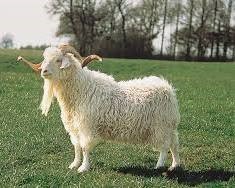
|
The illustrious Angora goat, named after the ancient city of Ankara in Turkey, holds a storied legacy as a premier producer of luxurious mohair fiber, renowned for its unparalleled softness and sheen.
Some trace the lineage of the Angora goat back to the majestic Central Asian Markhor goat, a noble ancestor revered since the Paleolithic era. In the 1550s, these graceful creatures made their grand debut in Europe, gracing the royal cour
...
|
|
 Appenzell Appenzell
|
|

|
The Appenzell Goat, characterized by its pure white coat and mid-length hair, is a breed renowned for its robust build and excellent milk production capabilities. With a well-built body and powerful, well-positioned legs, this hornless breed typically stands at a height ranging from 70 to 80 cm and weighs between 45 kg to 65 kg.
In terms of milk production, the Appenzell Goat is comparable to other dairy goat breeds. During lactation,
...
|
|
 Arapawa Arapawa
|
|

|
The Arapawa Goat is one of the rarest goat
breeds in the world and is critically close to extinction.
The Arapawa Goat is a breed of feral goat
descended from Old English milch goats released on Arapawa Island off the coast
of New Zealand. It is directly descended from a breed of English landrace goat
which no longer exists in its native England. Extremely rare today, a few have
been exported to North America and other regions. T
...
|
|
 Argentata dell Etna Argentata dell Etna
|
|
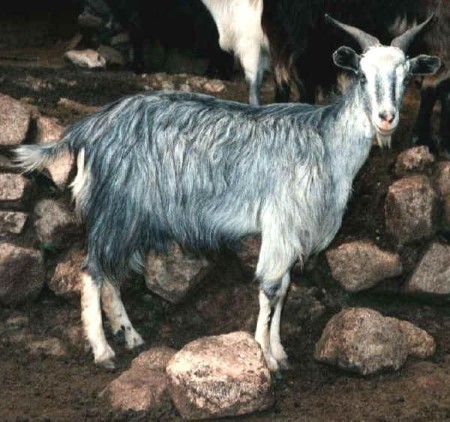
|
The illustrious Argentata dell'Etna Goats trace their lineage to the majestic landscapes of Mount Etna and the Peloritani mountains, casting a captivating presence across the Sicilian terrain. Revered for their distinctive attributes and regional significance, these goats are cherished not only for their contributions to agriculture but also for their symbolic connection to the volcanic splendor of their homeland.
Steeped in mystery an
...
|
|
 Aspromonte Aspromonte
|
|
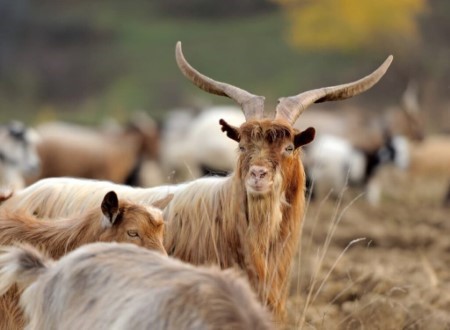
|
Aspromonte Goats are a breed of domestic goat that originated in the Aspromonte National Park in Calabria, Italy. They are known for their hardiness and adaptability to harsh environments. They are medium-sized animals, with males weighing around 150-200 pounds and females weighing around 100-150 pounds. They have a long and thick coat, which can be white, black, or a mix of the two colors. They are primarily used for milk and meat production, bu
...
|
|
 Auckland Island Auckland Island
|
|
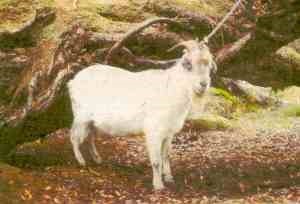
|
Goats are reported to have been liberated in at least ten
places on the Auckland Island group, New Zealand, in the second half of the
nineteenth century as food for castaways, with at least one liberation in 1865
on the main Auckland Island. In 1934 the islands were defined as Nature
Reserves and today they are administered by the Department of Conservation. By
the 1970s, only one population of about a hundred goats remained, these living
o
...
|
|
 Australian Cashmere Australian Cashmere
|
|

|
Long before the British settled
Australia, goats were released on the islands off the coast of Australia by
Dutch and Portuguese navigators. These goats come from a great variety of
backgrounds and they acclimatized readily to the Australian environment.
In 1832 William Riley, imported
goats to his property at Raby, New South Wales. Also he delivered a paper to
the Agricultural and Horticultural Society of New South Wales in an e
...
|
|
 Bagot Bagot
|
|

|
For several hundred years bagot goats have lived
semi-wild atBlithfield Hall
in Staffordshire, England. Bagot goats were introduced to England at Blithfield
Hall in the 1380s. They were probably brought back to England by returning Crusaders,
and probably trace their ancestry to goats of the Rhone valley. The goats were
said to have been given to John Bagot of Blithfield by King Richard II of England
to commemorate the good hunting the King
...
|
|
 Barbari Barbari
|
|

|
Barbari goats, originating from Pakistan, are a prized breed known for their suitability for meat production. These small-sized goats exhibit a creamy to golden white coat, occasionally adorned with distinctive spots. Their meat conformation is highly regarded, making them sought after in the meat market.
One of the notable characteristics of Barbari goats is their remarkable reproductive performance. They are renowned for triple kiddi
...
|
|
 Beetal Beetal
|
|

|
Beetal goats, also known as Amritsari goats, are renowned for their dual-purpose capabilities, excelling in both meat and milk production. Originating from the regions of Pakistan and India, these goats are esteemed for their versatile contributions to agriculture and commerce.
Typically adorned in shades of red, black, or pied, Beetal goats showcase distinctive pendulous ears that add to their characteristic appearance. The males of t
...
|
|
 Belgian Fawn Belgian Fawn
|
|

|
Belgian Fawn goats, originating from Belgium, share ancestral ties with the Chamois Colored goats of Switzerland and maintain a close kinship with the Oberhasli goats bred in the United States. Exhibiting distinct traits within the goat community, these goats are esteemed for their multifaceted qualities and adaptive nature.
Adorned with striking horns, Belgian Fawn goats boast coats that span from deep blacks to rich browns, accentuat
...
|
|
 Benadir Benadir
|
|

|
Benadir goats, native to the Webi Shibeli region of southern Somalia, are prized for their dual-purpose nature, serving as valuable assets in both meat and milk production. Renowned for their versatility, these goats play a significant role in sustaining the livelihoods of local communities by providing essential food resources.
These goats exhibit a distinctive appearance, often characterized by red or black spotted coats, which not o
...
|
|
 Bhuj Bhuj
|
|

|
Bhuj goats, native to northeastern Brazil, are valued for their dual-purpose capabilities, serving as reliable sources of both milk and meat. Renowned for their adaptability to the region's environmental conditions, Bhuj goats typically exhibit a striking black coat adorned with white or spotted lop ears and feature a distinctive Roman nose.
Originating from the Kutchi goats of India, Bhuj goats have been selectively bred to thrive in
...
|
|
 Bilberry Bilberry
|
|

|
Bilberry
goats are a unique breed of feral goats that
are believed to have lived in one herd on Bilberry Rock in Waterford City in the south of Ireland for
hundreds of years. They are large, with shaggy coats and very large horns.
Bilberry
goats are not like any other breed of goat found in Ireland or Great Britain,
the Bilberry herd is thought to be related to Pashmina, Maltese or Cashmere
goats. Locals believe they came over with the
...
|
|
 Bionda dell'Adamello Bionda dell'Adamello
|
|

|
Bionda dell'Adamello goats are from the northern Italian Region of
Lombardia. They got their name from the color of their hair - Bionda in Italian
means Fair - and from the mountain "Adamello" which is part of the
Italian Alps.
Bionda dell'Adamello goats appear to be of ancient origin. A
painting from about 1760 by the Milanese painter Francesco Londonio shows a
Bionda dell'Adamello goat.
Bionda dell'Adamello goats are
...
|
|
 Black Bengal Black Bengal
|
|

|
Black Bengal
goats come from northeastern India and throughout Bangladesh. They are a small meat
and dairy goats. The Black Bengal is a prolific breed and while usually black
it is also found in brown, white, or gray. They have a short coat and ears and
are bearded. They have small horns and short legs. An adult male goat weights
about 25 to 30 kg and female 20 to 25 kg.
They are poor at
milk production, but they produce high-qu
...
|
|
 Boer Boer
|
|
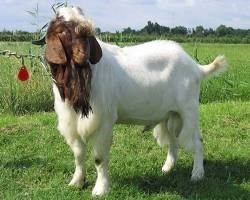
|
Boer Goats, originating from South Africa, are renowned as a meat breed and derive their name from the Afrikaans word "boer," meaning farmer.
Initially developed through selective breeding, Boer Goats likely have ancestry tracing back to indigenous goat populations of the Namaqua Bushmen and the Fooku tribes, possibly influenced by Indian and European bloodlines. Selected for their meat-producing qualities, these goats have evolved int
...
|
|
 Booted Booted
|
|

|
Booted Goats, a distinctive Swiss variety of Mountain Goat, embody resilience, vitality, and robustness in their breed characteristics. These horned goats exhibit a striking appearance, adorned with vibrant hues ranging from bright gray-brown to dark red-brown, accentuated by striking black or brown markings resembling "boots."
Historically, Booted Goats were purposefully bred, recognized for their valuable attributes. However, by the
...
|
|
 Bormina Bormina
|
|
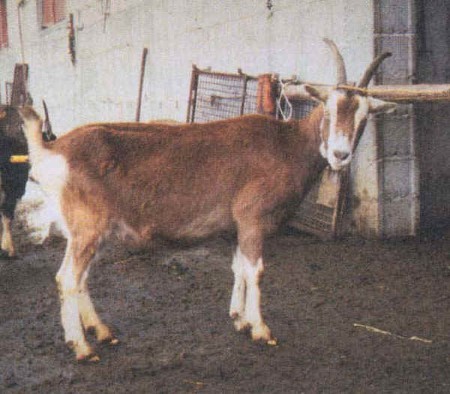
|
Bormina goats, originating from the picturesque region of Bormio in Northern Italy, are a delightful fusion of local Italian goat varieties and the esteemed Toggenburg Goats from Switzerland. Renowned for their exceptional milk production, these goats thrive in the fertile valleys and alpine meadows of Valtellina, where they contribute to the rich dairy heritage of the region.
With their medium to large build and captivating light brow
...
|
|
 British Alpine British Alpine
|
|

|
British Alpine goats, originating in Great Britain in the early 1900s, made their way to Australia in 1958, where they have since thrived and evolved through selective breeding programs. These goats have been enhanced by crossbreeding with Saanen and Toggenburg does, resulting in an improved lineage with desirable traits.
Distinguished by their tall, rangy, and graceful stature, British Alpine goats boast a striking appearance with bla
...
|
|
 Brown Shorthair Brown Shorthair
|
|

|
Since the twilight of the 19th century, the Brown Shorthair Goats have undergone a process of refinement and enhancement that has elevated them to a distinguished status. Originating from a native breed characterized by an array of hues, ranging from light-brown to ivory, these goats embarked on a journey of improvement through strategic crossbreeding with the esteemed German brown (Erzgebirgziege) bucks.
In a seminal moment of recogni
...
|
|
 Cabra Majorera Cabra Majorera
|
|

|
The Cabra Majorera, also known as the Fuerteventura Goat, stands as a proud symbol of the rich dairy heritage of the Canary Islands. Renowned for its role in the production of Majorero cheese, this breed of dairy goat embodies resilience and strength.
Majorera Goats are not merely livestock; they are esteemed partners in the culinary traditions of the region, contributing to the creation of Majorero cheese, a delicacy beloved by locals
...
|
|
 Canary Island Canary Island
|
|

|
Canary Island Goats, native to Spain, grace the rugged landscapes of the Canary Islands with their presence, primarily revered for their exceptional milk production capabilities. These hardy creatures exhibit a remarkable diversity of colors, painting the pastoral scenery with hues ranging from earthy browns to creamy whites and everything in between. Sporting sabre-shaped or twisted horns, they possess a distinctive charm that speaks of their an
...
|
|
 Caninde Caninde
|
|

|
Caninde goats, originating from northeastern Brazil, feature a predominantly black coat adorned with light stripes on their face, chest, and lower legs. Renowned for their adaptability to the harsh environmental conditions of the region, these goats excel in semi-arid climates. Their resilience allows them to thrive in challenging landscapes, where they demonstrate remarkable foraging abilities.
Primarily bred for meat production, Can
...
|
|
 Capestrina Capestrina
|
|
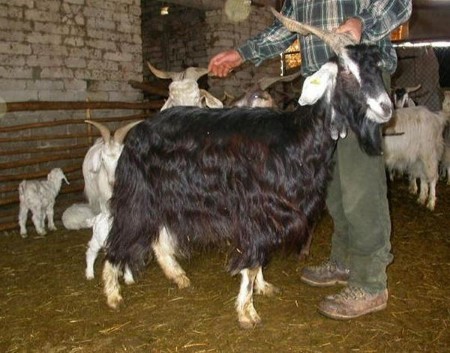
|
The resilient Capestrina Goats, believed to have originated amidst the rugged landscapes of the Lepini, Ausoni, and Aurunci mountains in the Latium region of Italy, embody a distinctive blend of strength and grace. Nestled within the provinces of Rome, Frosinone, and Latina, these goats have carved out their niche in the pastoral tapestry of the Italian countryside.
Often found in the company of Ciociare and Monticelliane goats, or the
...
|
|
 Capra di Tavolara Capra di Tavolara
|
|
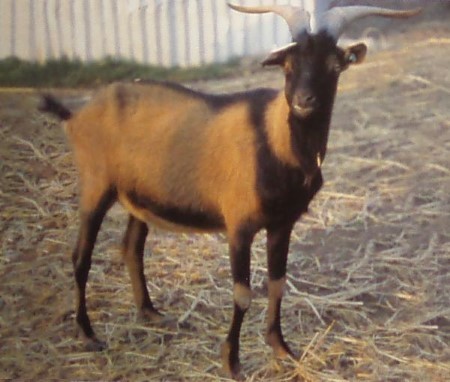
|
In the craggy cliffs and sun-drenched shores of Tavolara, Italy, a breed of goat thrives in harmony with its untamed surroundings - the Capra di Tavolara. With coats the color of rich earth and eyes that gleam with untamed spirit, these goats are a living testament to the rugged beauty of their island home.
Resembling their wild ancestors, the Capra di Tavolara bears the hallmarks of their untamed lineage. Their sturdy limbs and sure-f
...
|
|
 Carpathian Carpathian
|
|

|
Carpathian goats, native to southeastern Europe encompassing regions like Romania and Poland, are prized for their dual-purpose utility in both meat and milk production. These hardy animals exhibit characteristic traits such as long hair and distinctive twisted horns, distinguishing them as a unique breed within the Carpathian mountain range.
In Romania, Carpathian goats are observed in a myriad of colors, showcasing the breed's geneti
...
|
|
 Casertas Casertas
|
|
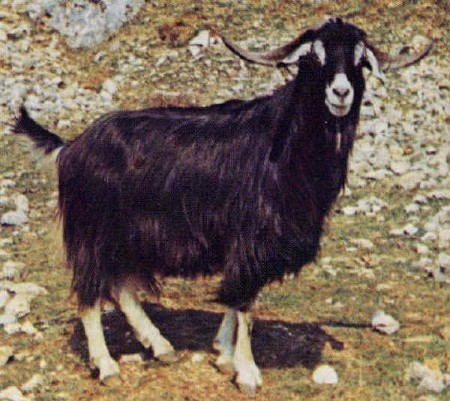
|
Casertas goats originate from the province of Caserta in the Campania region of Italy. They are primarily found in this area, although specific details about their distribution beyond this region are not widely documented. Casertas goats are typically of medium size and are known to bear horns.
|
|
 Cashmere Cashmere
|
|

|
A cashmere goat, belonging to any breed that produces cashmere wool, is highly valued for its fine, soft, downy winter undercoat, which is coveted for commercial use in luxury textiles and apparel. The name "cashmere" originates from the region of Kashmir, nestled within the wild and mountainous landscapes of India and Pakistan, although historically, the fiber was sourced from Tibet and woven into fabric in Kashmir.
During the 15th ce
...
|
|
 Chamba Chamba
|
|

|
Chamba Goats, indigenous to the majestic Himalayan region of India, are revered for their robust constitution and distinctive soft white hair. These hardy goats play a vital role in the livelihoods of communities nestled within the rugged terrain of the Himalayas, where their strength and agility are harnessed for transporting goods across the challenging hilly landscapes.
Bearing testament to their adaptability and resilience, Chamba
...
|
|
 Chamois Colored Chamois Colored
|
|

|
Chamois Colored Goats, originating from Switzerland, are dual-purpose animals bred for both their dairy and meat production capabilities. Sporting a distinctive chamois-colored coat, they are characterized by brown fur adorned with black face-stripes, a prominent back stripe, and markings on their belly and legs.
These goats exhibit versatility in their horn structure, being either horned or polled, offering options for different breed
...
|
|
 Chappar Chappar
|
|

|
Out there in the vast, rolling plains of Pakistan, where the sun beats down mercilessly and the wind whispers secrets across the rugged landscape, you'll find the Chappar Goats. These ain't your ordinary goats, no sir. They're small, sleek, and as black as the darkest night, blending into the shadows of the land like they were born from the very earth itself.
Now, let me tell you about their meat, son. It's something to behold. The con
...
|
|
 Charnequeira Charnequeira
|
|

|
Charnequeira goats, indigenous to Portugal, are esteemed for their dual-purpose capabilities in meat and milk production. These goats, often admired for their robust build and adaptable nature, play a significant role in Portugal's agricultural landscape.
Typically adorned in shades of red, Charnequeira goats occasionally exhibit pied coloring, adding a touch of variety to their appearance. While some individuals are naturally polled,
...
|
|
 Chengde Polled Chengde Polled
|
|

|
Chengde Polled Goats, a distinct breed primarily valued for their meat and coveted cashmere wool, are native to the northern Hebei province of China. Renowned for their unique genetic traits and dual-purpose capabilities, these goats play a crucial role in the local economy and traditional husbandry practices.
Hailing from the picturesque landscapes of northern Hebei, Chengde Polled Goats are specifically bred and raised for their high
...
|
|
 Chengdu Brown Chengdu Brown
|
|
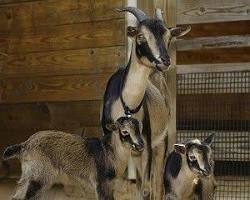
|
Chengdu Brown Goats, hailing from the picturesque Sichuan Province of China, represent a prolific breed valued for their contributions to both meat and milk production. Exhibiting a distinctive brown hue, these goats are characterized by a dark face and prominent back stripes, adding to their unique allure.
Renowned for their dual-purpose capabilities, Chengdu Brown Goats are esteemed for their ability to yield both quality meat and mi
...
|
|
 Chigu Chigu
|
|
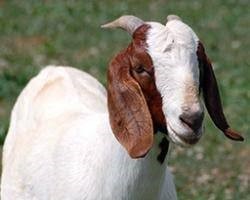
|
Chigu Goats, native to India, are selectively bred for their prized cashmere wool and meat. These goats are characterized by their distinctive white coat and are known to possess long, twisted horns, adding to their striking appearance.
Highly valued for their dual-purpose nature, Chigu Goats contribute significantly to the cashmere industry while also serving as a source of nutritious meat. Their adaptability to various climates and t
...
|
|
 Ciavenasca Ciavenasca
|
|
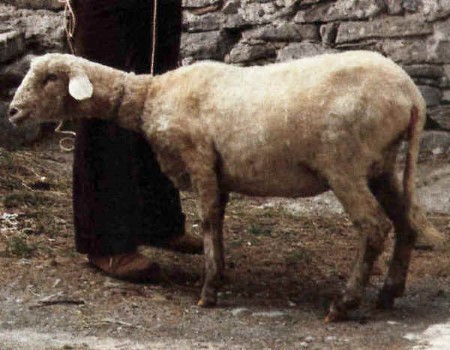
|
Ciavenasca Goats, hailing from the picturesque Val Chiavenna in Lombardy, Italy, are esteemed members of the alpine group of goats, thriving in the rugged terrain of their mountainous homeland. Commonly reared in this region, they epitomize adaptability to high-altitude grazing and embody the resilient spirit of mountain-dwelling livestock.
Standing proudly at heights of 75-80 cm at their withers, Ciavenasca Goats present a striking ar
...
|
|
 Cilentana Fulva Cilentana Fulva
|
|
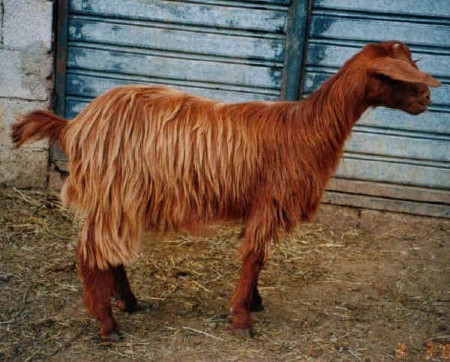
|
Cilentana Fulva goats, adorned in hues of vibrant red, hail from the sun-kissed lands of southern Italy. Revered for their remarkable resilience and adaptability to the challenging local terrain characterized by rugged hills and arid soils, these goats stand as testament to nature's ability to thrive amidst adversity.
These goats are revered not only for their striking appearance but also for their invaluable contributions to the agric
...
|
|
 Ciociara Grigia Ciociara Grigia
|
|
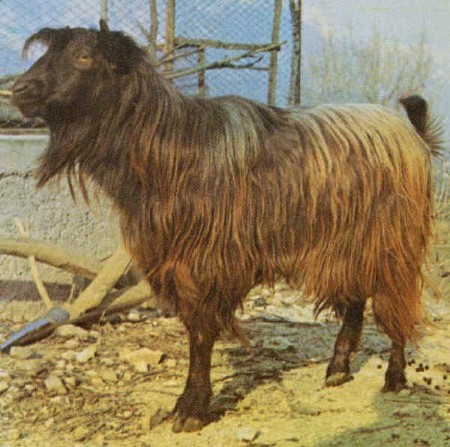
|
Ciociara Grigia, fondly known as the "Two Women Grey" Goats, are believed to have their origins rooted in the majestic Mount Ausoni and Aurunci regions of Italy, where a resilient few still thrive today. Adorned in a coat of plain silver grey, blending both light and dark hues, these goats exude an aura of timeless elegance with their long-haired, silken pelts enveloping a sleek grey skin.
With a versatile presence, Ciociara Grigia goa
...
|
|
 Corsican Corsican
|
|

|
Corsican Goats, native to the picturesque French island of Corsica, are prized for their long, luxurious coats and are primarily raised for milk production. These goats are cherished for their ability to thrive in the rugged terrain and varied climates of Corsica, making them well-suited to the island's environment.
Known for their versatility and adaptability, Corsican Goats come in a wide range of colors, adding to the diversity of t
...
|
|
 Damani Damani
|
|

|
Damani goats, indigenous to the Bannu and Dera Ismail Khan districts in Pakistan, are highly regarded as milk-producing goats in the region. Medium-sized and well-adapted to the local climate, these goats have a mature weight averaging around 35 kg, making them suitable for small-scale and subsistence farming.
Their distinctive appearance includes a long black hair coat with a tan head and legs, providing them with natural camouflage i
...
|
|
 Damascus Damascus
|
|

|
Damascus Goats, also recognized as Aleppo, Halep, Baladi, Damascene, Shami, or Chami Goats, are primarily raised in Syria and Lebanon, predominantly for their milk production.
Belonging to the Nubian type, Damascus Goats are distinguished by their long hair and commonly exhibit shades of red or brown, although they can also display pied or grey coloration. The breed may possess either horned or polled characteristics, offering flexibil
...
|
|
 Danish Landrace Danish Landrace
|
|

|
The ancestors of today’s Danish
Landrace Goats have been in Denmark since 3400 BC, however, this sturdy breed
has seen a lot of cross breeding which has left the number of true Danish
Landrace Goats rather limited.
At the beginning of the 20th
century, many were crossed with goats from the German Harz region and Saanen. After
world war II many Danish Landrace Goats were used as recipients for embryo
transfer of Angora or Boer go
...
|
|
 Dera Din Panah Dera Din Panah
|
|
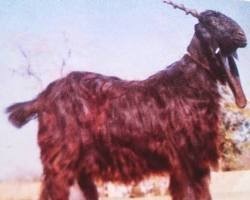
|
Dera Din Panah goats, originating from the Multan and Muzaffargarh districts of the Punjab province in Pakistan, are renowned for their robust physique and distinct physical characteristics. These goats boast a well-developed body adorned with long, lustrous black hair, which adds to their striking appearance. Their most notable features include their long, hanging, and twisted ears, along with spiral horns that contribute to their unique and imp
...
|
|
 Dons Dons
|
|

|
The Dons, a medium-sized goat breed originating from the Don River of the Lower Volga territory in Russia, are prized for their exceptional contributions to wool, goatskin, and milk production.
Discovered in 1933-34 by an expedition of the All-Union Institute of Sheep and Goat Husbandry during studies in the former Lower Volga territory, Dons boast a strong constitution, excellent conformation, and a notable undercoat wool covering the
...
|
|
 Duan Duan
|
|
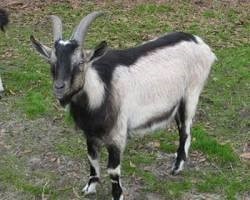
|
Duan Goats, indigenous to the Guangxi Province in China, have long been prized for their role in meat production, contributing to the culinary traditions of the region. These goats, known for their robust build and sturdy constitution, are bred primarily for their succulent meat, which is favored for its rich flavor and tenderness.
In terms of appearance, Duan Goats exhibit a striking variety of colors, including black, white, and pied
...
|
|
 Dutch Landrace Dutch Landrace
|
|

|
Dutch Landrace Goats, originating from the Netherlands, stand as a testament to the rich heritage of the region's agricultural traditions. Belonging to the esteemed lineage of northwest European "Landrace" goat breeds, they are considered one of the original breeds indigenous to the Netherlands.
These goats are characterized by their medium size and distinctive horns, which contribute to their robust appearance. While they may vary in
...
|
|
 Dutch Toggenburg Dutch Toggenburg
|
|

|
Dutch Toggenburg Goats, renowned for their milking prowess, trace their origins to the Netherlands, where they were meticulously developed through strategic crossbreeding efforts. This distinctive breed emerged from the careful fusion of native Dutch goats with the renowned Toggenburg goat, resulting in a lineage uniquely tailored to thrive in the Dutch landscape.
With a focus on enhancing milk production and quality, Dutch Toggenburg
...
|
|
 Erzgebirge Erzgebirge
|
|

|
Erzgebirge Goats, also referred to as Passeirer Gebirgsziege or Erzgebirgsziege, hail from Saxony, Germany, and are recognized for their distinct characteristics. These goats are typically polled and feature a reddish-brown coat adorned with striking black stripes on their face, back, and legs.
While Erzgebirge Goats were historically valued for their milk production, the breed is currently facing critical endangerment. Efforts to pres
...
|
|
 Fasana Fasana
|
|
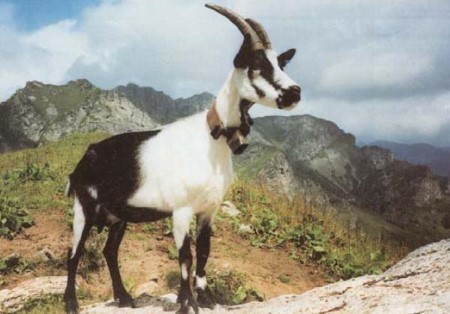
|
Fasana, also known as Colombina, are medium-sized goats originating from the picturesque region of Piedmont, Italy. Renowned for their elegance and moderate size, these goats are affectionately referred to as "Pavone" in Austria, France, and Germany, a nod to their regal bearing reminiscent of a peacock's majestic demeanor.
With their origins rooted in the verdant landscapes of Piedmont, Fasana goats exhibit a graceful stature and dist
...
|
|
 Finnish Landrace Finnish Landrace
|
|

|
Finnish Landrace goats, primarily located in western Finland, are selectively bred for their milk production, making them valuable assets to the dairy goat farming industry. These goats are available in both polled and horned varieties, offering flexibility in breeding programs and management practices.
Known for their dairy prowess, Finnish Landrace goats typically exhibit a white coat, although variations in color such as gray or pie
...
|
|
 Frontalasca Frontalasca
|
|
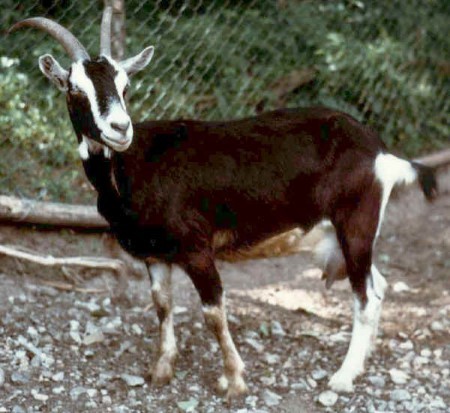
|
Frontalasca Goats, native to Frontale in Val Rezzalo, Italy, embody the rustic charm and rugged beauty of their Alpine origins. Bearing a striking resemblance to the esteemed Swiss Grigionese Goats, they roam the picturesque valleys of Valtellina, Val Malenco, Val Masino, and Valchiavenna, thriving amidst the breathtaking landscapes of northern Italy.
Cloaked in sleek black coats adorned with elegant white streaks tracing their head, b
...
|
|
 Garganica Garganica
|
|

|
Garganica, or Fulva
Lucchese, Goats represents the typical goat breed of the Ligurian Tuscan and
Emilian Appennines, particularly in the provinces of Lucca (Tuscany) and
Garfagnana. They were derived from cross-breeding of
local animals with goats imported from western Europe, probably at the same
time as the importation of Merino sheep that led to the formation of the
Gentile di Puglia sheep breed.
Garganica medium-height
goats
...
|
|
 Girgentana Girgentana
|
|

|
Girgentana Goats, hailing from the picturesque region of Agrigento, Sicily, are a testament to the rich agricultural heritage of the area. Once a thriving population gracing the hills and coastal zones of the province, with numbers surpassing 30,000, these goats have seen a dramatic decline in recent years, with the registered population now dwindling to under 500.
These goats are distinguished by their remarkable horns, which graceful
...
|
|
 Goinget Goinget
|
|

|
The story of the Goinget, or Göinge, goats, hailing from the picturesque landscapes of Sweden, is a tale woven with threads of heritage, resilience, and conservation.
These goats, unlike their counterparts bred for milk or meat, follow a different trajectory in the annals of livestock history. Their breeding selection, far from the meticulous curation seen in traditional breeding programs, takes on a more organic, even serendipitous, h
...
|
|
 Golden Guernsey Golden Guernsey
|
|

|
The Golden Guernsey, a rare and esteemed breed of goat originating from the picturesque Bailiwick of Guernsey in the Channel Islands, holds a special place in the history and culture of the region. Since its export to Great Britain in 1965, the breed has captured the admiration of goat enthusiasts and farmers alike, leading to the establishment of the English Golden Guernsey Club, later renamed the Golden Guernsey Goat Society, to promote and pre
...
|
|
 Grigia Molisana Grigia Molisana
|
|
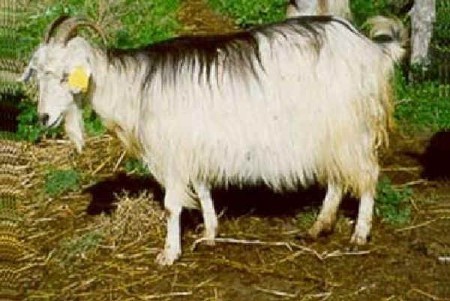
|
The Grigia Molisana goats, native to the picturesque landscapes of Italy, specifically thrive in the provinces of Campobasso and Isernia within the Molise Region. Their presence is particularly pronounced in the charming town of Montefalcone nel Sannio, where they play an integral role in the region's agricultural heritage.
Believed to be a composite of various local breeds including the Maltese, Garganica, and Alpina, the Grigia Molis
...
|
|
 Grisons Striped Grisons Striped
|
|

|
The Grisons Striped, a resilient goat breed hailing from the picturesque landscapes of Switzerland, epitomizes rugged durability and thrives amidst the mountainous terrain of its homeland. With a penchant for grazing in stony landscapes, these hardy goats feel right at home in the challenging environments of the Swiss mountains.
Despite their remarkable adaptability and resilience, the Grisons Striped goat faced a precarious situation
...
|
|
 Hailun Hailun
|
|
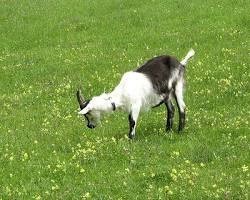
|
Hailun Goats, hailing from the Heilongjiang region of China, stand as a testament to the fusion of international breeding expertise with local resilience. With coats ranging from the deepest blacks to striking pied patterns, and hues spanning from grey-brown to sunny yellow, these goats boast a diverse palette of colors that mirror the rich tapestry of their origins.
Their ancestry traces back to a carefully orchestrated union between
...
|
|
 Haimen Haimen
|
|
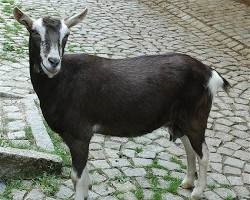
|
Haimen Goats, hailing from the lush region of Zhejiang, China, are revered for their remarkable attributes, particularly their prowess in meat production and prolific reproductive capabilities. Admired for their elegant white coat, these goats embody the essence of vitality and productivity in agricultural settings.
Renowned for their prolific reproduction, Haimen Goats are prized for their ability to maintain robust breeding cycles, e
...
|
|
 Hasi Hasi
|
|

|
Hasi Goats, known as the larger mountain variation of the Albanian Goats, hail from the rugged terrain of northeastern Albania, where they have been meticulously bred for generations to excel in both milk and meat production. These goats are esteemed for their versatility and adaptability to the challenging mountainous landscapes of the region, where they play a crucial role in the livelihoods of local farmers.
One of the distinguishin
...
|
|
 Hejazi Hejazi
|
|

|
Hejazi goats, originating from Arabia, are renowned as meat goats prized for their robust build and flavorful meat. Typically characterized by their striking black coats and long, flowing hair, these goats are bred primarily for meat production. The dark coloring of their coats provides them with a distinct appearance and offers some level of camouflage in their natural habitat.
Due to their adaptation to arid climates and rugged terra
...
|
|
 Hexi Cashmere Hexi Cashmere
|
|

|
The Hexi Cashmere goat, primarily found in China, holds a prestigious position in the realm of cashmere fiber production. Revered for its luxurious fleece, this breed typically exhibits a pristine white coat, although variations in color such as black, brown, or pied are also observed.
The legacy of cashmere production traces back to the ancient region of Kashmir, nestled amidst the rugged terrain of India and Pakistan. Despite its ori
...
|
|
 Hongtong Hongtong
|
|
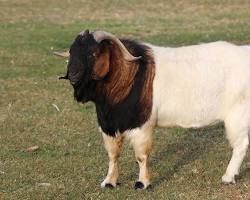
|
Hongtong Goats are renowned as a prominent breed of white milk goats that trace their origins to a strategic crossbreeding between Saanen goats and indigenous local goat varieties. This deliberate crossbreeding endeavor aimed to combine the superior milk-producing capabilities of Saanen goats with the adaptability and resilience of the local goat breeds, resulting in a hybrid breed known for its exceptional milk yield and overall robustness.
|
|
 Huai Huai
|
|
|
Huai Goats, indigenous to the Henan region of China, are predominantly white in color and are commonly raised for their meat. These goats exhibit variations in horn structure, with some individuals being horned while others are polled, contributing to the breed's genetic diversity.
Originating from the fertile lands of Henan, Huai Goats have adapted to the region's climate and terrain, thriving in agricultural landscapes. Their white c
...
|
|
 Huaitoutala Huaitoutala
|
|
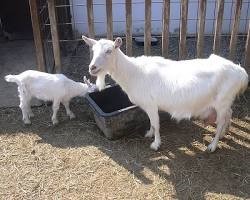
|
Nestled amidst the rugged terrain of Qinghai, China, roams a breed of goat as resilient as the land itself - the Huaitoutala Goat. Named for its homeland, this cashmere goat possesses a rugged elegance that speaks of its adaptation to the harsh mountainous environment.
With a coat as precious as the finest silk, the Huaitoutala Goat boasts a luxurious cashmere fleece that has captured the attention of artisans and connoisseurs alike. S
...
|
|
 Hungarian Improved Hungarian Improved
|
|
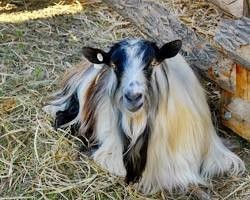
|
Hungarian Improved Goats are a specialized milk-producing breed developed through meticulous breeding practices involving local goats and Swiss dairy breeds, notably Saanen goats.
Initially bred through selective breeding programs, Hungarian Improved Goats are renowned for their exceptional milk production capabilities. Their lineage traces back to carefully curated crosses between indigenous goat varieties and Swiss dairy breeds, part
...
|
|
 Icelandic Icelandic
|
|

|
Icelandic Goats, also known as Settlement goats, are an
ancient domestic goat breed believed to be of Norwegian origin and dating back
to the settlement of Iceland over 1100 years ago.
Iceland Goats have been isolated for several centuries, which
mean that they are highly inbred. Under their coarse, long guard hair they have
a coat of high quality cashmere fiber. Icelandic goats are kept mainly as pets
and currently have no econo
...
|
|
 Irish Irish
|
|

|
Irish Goats, with their majestic long-haired coats, have carved a niche in the rugged landscapes of Ireland, where they are cherished for their versatility and adaptability. While not indigenous to the Emerald Isle, these domesticated goats have seamlessly integrated into the fabric of Irish agricultural traditions, their presence woven into the tapestry of the countryside for centuries.
In the verdant hills and valleys of Ireland, fer
...
|
|
 Istriana Istriana
|
|
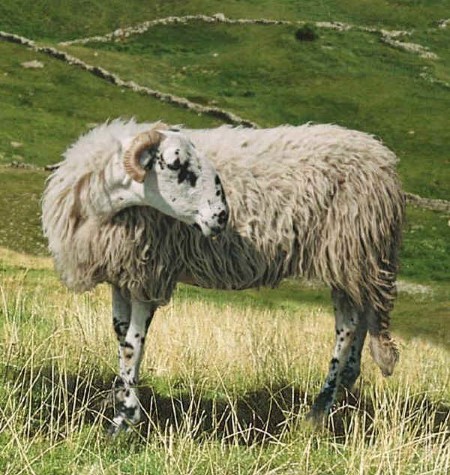
|
Istriana Goats hail from the picturesque region of Istria, once part of Italy and now nestled within the borders of modern-day Croatia. Evolving through a blend of indigenous heritage and Alpine influences, these goats embody the rich tapestry of their historical lineage. Bred with meticulous care in the province of Gorizia, their population, once modest, has steadily thrived, boasting just over 100 heads by the year 1983.
Adorned in p
...
|
|
 Jamnapari Jamnapari
|
|

|
Jamnapari (or Jamunapari) goats,
ancestors of the American Nubian, originated in Indian and are bred for both
milk and meat. Since 1953 they have been imported to Indonesia (popular as
Etawa goat, and its mixture with a local goat called "PE", Peranakan
Etawa or Etawa mix) where they have been a great success. The name is derived
from the rivers Yamuna, Jamuna (West Bengal) and Jamuna (Bangladesh) of India
and Bangladesh. In India there wer
...
|
|
 Jining Grey Jining Grey
|
|

|
Jining Grey Goats are from the
Shandong Province of China, where they are used for kid pelt and cashmere fiber
production. They are known for the attractive wavy
patterns of its kid-pelt.
Well-raised
Does raised reached maturity at 3-4 months of age, and may give two kiddings a
year, or three kiddings in two years. They are very prolific, with an average
kidding rate of 294 percent.
Both genders
have horns and carry a
...
|
|
 Jonica Jonica
|
|

|
Jonica Goats, indigenous to the province of Taranto in southern Italy, represent a heritage breed deeply intertwined with the region's pastoral traditions. Their origin story traces back to a deliberate crossbreeding of local goat varieties with Maltese goats, resulting in a unique lineage that embodies the rich agricultural heritage of Italy.
Renowned as one of the esteemed autochthonous Italian goat breeds, Jonica Goats are prized fo
...
|
|
 Kaghani Kaghani
|
|

|
Kaghani goats, hailing from the picturesque valley of the Hazara district in Pakistan, are revered for their multifaceted utility in the realm of livestock farming. These robust creatures, known for their imposing size, serve as indispensable assets for both cashmere fiber and meat production, embodying the essence of sustainability and productivity in the agricultural landscape of the region.
In terms of physical characteristics, Kagh
...
|
|
 Kalahari Kalahari
|
|

|
Kalahari Red goats, originating from the arid landscapes of the Kalahari Desert in South Africa, are renowned for their distinct red coloration and robust meat-producing capabilities. These goats have adapted to thrive in harsh desert conditions, showcasing their resilience and hardiness.
Bred primarily for their high-quality meat, Kalahari Red goats are valued for their ability to efficiently convert sparse vegetation into nutritious
...
|
|
 Kalbia Kalbia
|
|
|
Kalbia goats, originating from Australia, are a robust breed primarily raised for meat production. Renowned for their adaptability to various climatic conditions, they thrive in the diverse landscapes of the Australian continent.
These goats are valued for their superior meat quality and rapid growth rates, making them highly sought after in the livestock industry. Their sturdy build and efficient conversion of forage into muscle contr
...
|
|
 Kamori Kamori
|
|

|
Kamori goats are a popular breed of milk goats found in the
districts of Dadu, Larkana and Nawab Shah in the Sind Province, Pakistan. They are famous because of their long ears and huge body, also for their unique color. A purebred Kamori goat has dark brown color with coffee or dark faun color small patches over its entire body.
Purebred Kamori goats are very expensive and rare. However
farmers crossbred pure Kamori Goats with Patai
...
|
|
 Kiko Kiko
|
|

|
Kiko Goats were bred in New
Zealand for meat production. The Maori word “Kiko” means flesh or meat. The breed
was developed by Garrick and Anne Batten of Nelson in the northern South Island.
The Kiko breed was established by crossbreeding selected feral does with
Anglo-Nubian, Toggenburg and Saanen bucks, with further cross-breeding in the
second and third generations. After four generations of selective breeding –
selection being on the gr
...
|
|
 Kinder Kinder
|
|

|
The Kinder Goat breed emerged in a serendipitous turn of events during the late summer of 1985 at Zederkamm Farm. With the unfortunate passing of their Nubian buck, two Nubian does were left without a mate. Determined not to separate them from their pygmy goat companions for breeding, the decision was made to breed them with the pygmy buck they had on-site. In a remarkable display of ingenuity, the resourceful buck successfully accomplished the b
...
|
|
 Kri-kri Kri-kri
|
|

|
The Kri-kri, also known as the Cretan Ibex or Agrimi, roams the rugged landscapes of the Eastern Mediterranean, with its domain limited to the island of Crete and a trio of nearby islets—Dia, Thodorou, and Agii Pantes.
These elusive creatures sport a light-brownish coat adorned with a distinct darker band encircling their necks. With a pair of impressive horns sweeping back from their heads, they navigate their wild habitat with agilit
...
|
|
 L'Aquila L'Aquila
|
|
|
The distinguished L'Aquila Goats hail from the picturesque province of L'Aquila, nestled amidst the enchanting landscapes of Italy. A true testament to the rich tapestry of heritage and tradition, these remarkable creatures embody a harmonious blend of local breeds and international influences.
A composite creation, L'Aquila Goats bear the indelible marks of their diverse lineage, drawing upon the esteemed bloodlines of Toggenburg goat
...
|
|
 LaMancha LaMancha
|
|

|
LaMancha Goat originated in US
state of Oregon by Mrs. Eula Frey. She combined short-eared goats of a type
found not only in LaMancha, but throughout spain. LaMancha Goats have excellent
dairy temperament and are an all-around sturdy animal that can withstand a
great deal of hardship and still produce. Through official testing this breed
has established itself in milk production with high butterfat.
LaMancha faces are straight wit
...
|
|
 Lariana Lariana
|
|
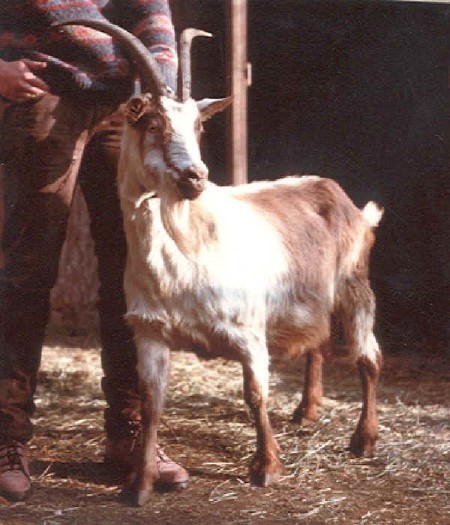
|
Lariana Goats, also known as the Goat of Livo, grace the picturesque landscapes on the western shores of Como Lake, nestled in the idyllic Livo valley of Italy. Belonging to the esteemed European alpine Group of Goats, they epitomize the rugged beauty and resilience of their mountainous habitat.
These goats, scattered across western Lario and its neighboring regions, exhibit a stunning array of coat colors, ranging from rich blacks and
...
|
|
 Loashan Loashan
|
|

|
Loashan Goats, indigenous to the picturesque landscapes of the Shandong Province in China, trace their origins back to a fascinating history of crossbreeding and selective breeding. In 1904, German preachers embarked on a mission of genetic enhancement, meticulously crossing local goat breeds with the esteemed Saanen Goats to create a new lineage with superior dairy traits.
Over the past seven decades, these goats have undergone a rema
...
|
|
 Maltese Maltese
|
|

|
Maltese goats, hailing from the eastern and central Mediterranean region, trace their origins back to Asia Minor, despite their name association with the island of Malta, where purebred specimens are absent. These long-haired dairy goats are predominantly raised in southern Italy, notably in the islands of Sicily and Sardinia, alongside their presence in Greece, Turkey, and the Maghreb.
Distinctive for their long, white hair with a bla
...
|
|
 Massif Central Massif Central
|
|

|
In the heart of the majestic Massif Central, where the rugged mountains and sprawling plateaux converge, there roam creatures of remarkable stature and resilience – the Massif Central Goats. Ah, but to truly appreciate these noble beasts, one must first understand the land from which they hail, a land of grandeur and untamed beauty.
Picture, if you will, the rugged terrain of the Massif Central, a region of south-central France where m
...
|
|
 Messinese Messinese
|
|

|
Messinese Goats, a distinguished dairy breed, hail from the picturesque Monti Nebrodi and Monti Peloritani regions in the province of Messina, nestled within the sun-kissed Mediterranean island of Sicily, Southern Italy. These goats also roam the provinces of Catania, Enna, and Palermo, adding to the richness of Sicily's agricultural landscape. Formerly known as the Capra dei Nebrodi or simply as the Siciliana Comune, the breed gained official re
...
|
|
 Mini LaMancha Mini LaMancha
|
|
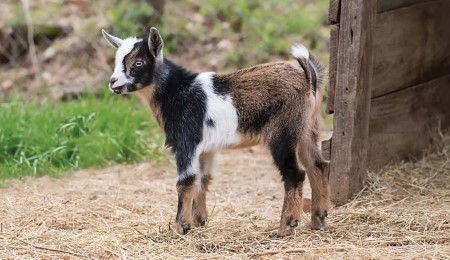
|
Mini LaMancha goats, the diminutive counterparts of the esteemed LaMancha breed, stand as a testament to American ingenuity and passion for agriculture. Developed exclusively in the United States, Mini-LaManchas inherit the admirable qualities of their larger counterparts while boasting a compact size and a host of endearing traits.
Renowned for their gentle and affable nature, Mini-LaManchas exude a calm and even temperament, making t
...
|
|
 Mini Oberhasli Mini Oberhasli
|
|

|
Mini Oberhasli, also known as Oberians or formally referred to as Miniature Oberhasli, goats are a delightful fusion of Nigerian Dwarf and Oberhasli breeds, specifically bred for their dairy prowess. These diminutive dairy darlings are prized for their milk production, churning out an impressive 4 to 10 pounds of milk per day.
Registered by the privately owned Miniature Dairy Goat Association (MDGA) and The Miniature Goat Registry, the
...
|
|
 Mini-Nubian Mini-Nubian
|
|
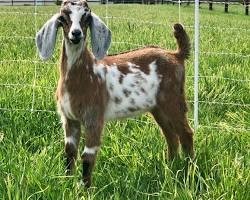
|
Mini-Nubian Goats are a mid-sized goat and are a cross
between Nigerian and Nubian goats.They are known for being a graceful, elegant goat that stand between 23-31 inches tall and come in any color or pattern of short, fine, glossy hair. They are know for their ease of milking; producing a high quantity and quality of milk whose butterfat yield is similar to that of the standard Nubian.
Breeding programs put emphasis on a structurally co
...
|
|
 Miniature Silky Fainting Miniature Silky Fainting
|
|
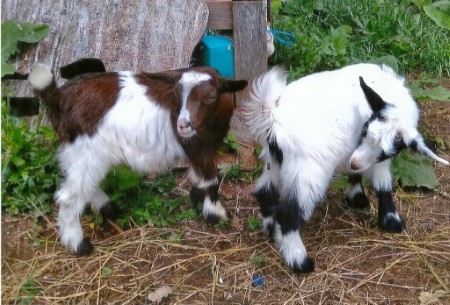
|
Miniature Silky Fainting Goats, renowned for their unique characteristics, stand out as a distinct breed within the goat community. Their diminutive size and manageable care requirements make them an attractive option for smaller farms, distinguishing them from their larger meat-oriented counterparts. Known by various monikers such as Myotonic Goats, Tennessee (Meat) Goats, and Nervous Goats, these charming creatures possess a fascinating trait t
...
|
|
 Montecristo Montecristo
|
|
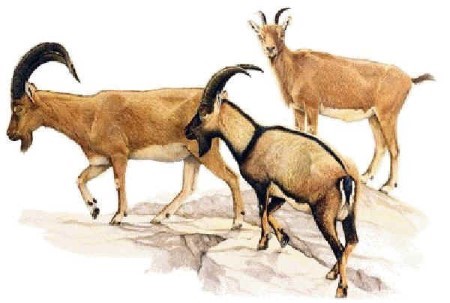
|
Montecristo Goats, known colloquially as the Goat of Montecristo, roam the rugged terrain of the eponymous isle nestled off the coast of Tuscany, Italy. Though not indigenous to the region, their ancestry traces back to the Roman goats of medieval times, which were later interbred with domestic goats. Over time, these goats have reverted to a wild state, their once-tame lineage now thriving in the untamed wilderness of Montecristo.
Ado
...
|
|
 Monticellana Monticellana
|
|
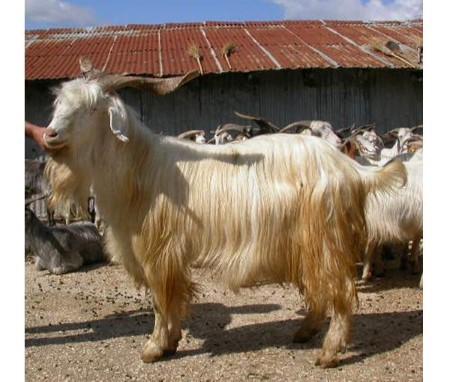
|
Monticellana Goats, also known as 'Bianca Romana', trace their roots back to the beginning of the 20th century in Latium, Italy. This rustic breed, named after the area of Monte San Biagio in the Province of Latina, Latium, is cherished by approximately thirty dedicated breeders who collectively nurture around one thousand heads.
Distinguished by their pristine white coats and rosily hued skin, Monticellana Goats present a striking app
...
|
|
 Moxotó Moxotó
|
|

|
Moxotó goats, native to northeastern Brazil, are meticulously bred for their remarkable resilience in the region's harsh semi-arid climates. Sporting a distinct white or cream-colored coat adorned with striking black face-stripes, back-stripes, and belly markings, their appearance serves both functional and aesthetic purposes.
Bred for their ability to thrive in challenging landscapes with limited access to water and vegetation, Moxotó
...
|
|
 Murcia-Granada Murcia-Granada
|
|

|
The Murcia-Granada Goats, originating from the southeastern region of Spain encompassing Murcia, Almería, Granada, and Alicante, are esteemed for their exceptional milk production and resilience in arid environments.
Adapted to the hot and dry conditions prevalent in the semiarid areas of southeastern Spain, Murcia-Granada Goats stand out as the most productive domestic animals in such climates, maintaining high milk production even un
...
|
|
 Murciana Murciana
|
|

|
Murciana Goats, also called
Murcian, Murcien, Murciene and Royal Murciana Goats are a used for both milk
and meat production. They originally are from the Murcia province - along the
Mediterranean coast of southeastern Spain.
While they have shorter ears
than many goat breed, Murciana Goats have an ear that is shaped like those of
the Swiss breeds, such as Alpines, Oberhaslis, and Saanens. Murciana Goats are
excellent milk produc
...
|
|
 Murgese di Foggia Murgese di Foggia
|
|
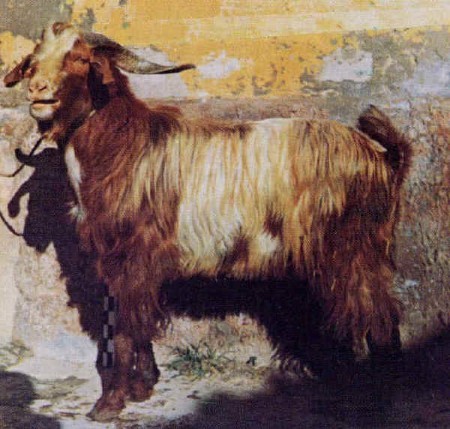
|
Murgese di Foggia Goats, once inhabitants of the picturesque province of Foggia, Italy, now exist only as echoes of a bygone era. Sadly, it is believed that this noble breed has succumbed to the passage of time, with its lineage fading into the annals of history.
Once a cherished part of the agricultural landscape in the region, these goats embodied the cultural heritage and rural traditions of Foggia. Their presence would have graced
...
|
|
 Myotonic Myotonic
|
|

|
Myotonic Goats, also known as
Wooden Leg, Stiff Leg, or Tennessee Fainting Goats are one of the few goats
that are indigenous to the U.S. There are two strains of this animal. Most of
those found in Tennessee and the eastern U.S. are smaller. Most Texas herds
tend to be somewhat larger, probably due to selective breeding for the meat
market. In fact, some ranchers have renamed them Tennessee Meat Goats.
Myotonic Goats are often sold
...
|
|
 Nachi Nachi
|
|

|
Nachi Goats, a treasured breed hailing from the Punjab Province of Pakistan, epitomize the essence of meat production with their robust stature and distinctive characteristics.
Nestled in the districts of Jhang, Multan, and Muzaffargarh, Nachi Goats command attention with their medium-sized frames and striking hues of black or brown. Their meat conformation, rated as medium, reflects their role as providers of succulent and flavorful m
...
|
|
 Napoletana Napoletana
|
|
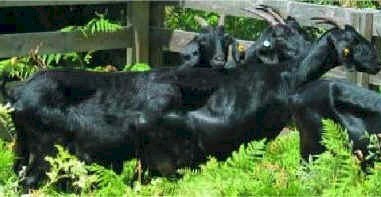
|
Originating from the vibrant city of Naples, Italy, Napoletana Goats epitomize the agricultural traditions deeply entrenched in the region's cultural fabric. Despite their historical significance, their numbers have dwindled in recent decades, underscoring the importance of preserving this distinctive breed.
Napoletana Goats are characterized by their striking coat, which typically exhibits a captivating blend of hues. While some indiv
...
|
|
 Nicastrese Nicastrese
|
|
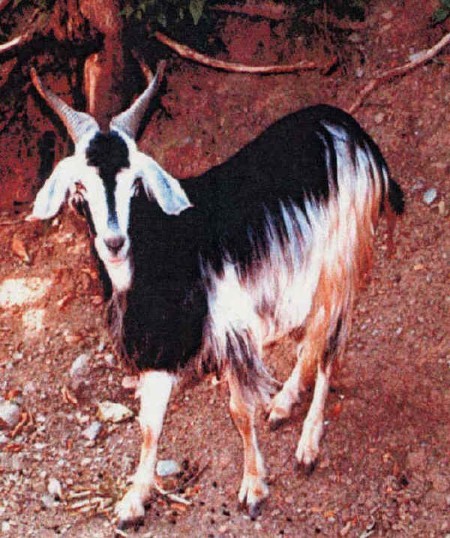
|
Nicastrese Goats originate from the Nicastro area, which is now known as Lamezia Terme, Italy, situated at the base of Mount Reventino. Primarily bred in the province of Catanzaro, these goats have gained popularity in neighboring provinces due to their favorable economic attributes.
Characterized by a black coat with white markings on the bosom, limbs, and portions of the head and possibly the sides, Nicastrese Goats exhibit long, smo
...
|
|
 Nigerian Nigerian
|
|

|
Nigerian Dwarf Goats are miniature
dairy goats from West African. They were originally brought to the United
States on ships as food for large cats such as lions, the survivors originally
lived in zoos. Nigerian Dwarf goats are popular as pets and family milkers due
to their easy maintenance and small stature. However, because of their high
butterfat, they are also used by some dairies to make cheese.
Nigerian Dwarf Goats are
re
...
|
|
 Nigora Nigora
|
|

|
Nigora Goats are medium-sized (19in
to 29in tall) milk and fiber goats. Nigora Goats are generally calm, amiable, and
laid back. Due to their good nature and size Nigora Goats are sold as pets, and
well as milk and fiber animals.
Nigora Goats originated in the
United States in the early 1990s. Early Nigoras contained a mixture of Nigerian
Dwarf, white and colored Angora goat bloodlines, as well as some small grade
fiber goat bree
...
|
|
 Norwegian Norwegian
|
|

|
Norwegian Goats, native to the picturesque landscapes of Norway, are revered for their versatile attributes, serving as valued assets in both milk and meat production. With their distinctive long-haired coats and striking color variations including gray, blue, white, and pied, these goats captivate the attention of farmers and breeders seeking reliable and multifaceted livestock options.
Renowned for their dual-purpose nature, Norwegia
...
|
|
 Nubian Nubian
|
|
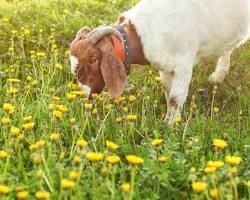
|
The Nubian, or Anglo Nubian, is an all-purpose goat,
useful for meat, milk and hide production. Nubian goats are known for the high
butterfat content of their milk, although on average, the breed produces less
milk than other dairy breeds.
Nubian goats are named for Nubia, in
northeastern Africa. The originally goats imported from Africa, Arabia, and
India were long-legged, hardy goats that had some characteristics desired by
goat br
...
|
|
 Oberhasli Oberhasli
|
|

|
Oberhasli Goats are a medium-sized dairy goat. Oberhasli
Goatsare Chamoisee- colored, ranging from light to a deep red
bay with black facial stripes, muzzle and forehead. Oberhaslis can also be
black in color.
Oberhasli are a modern
American breed of dairy goat. They derive from a subtype of goat from the
Oberhasli district of the Bernese Oberland in central Switzerland. All purebred
members of the breed descend from five chamois
...
|
|
 Orobica Orobica
|
|

|
The Orobica, also known as Valgerola Goat, is a medium-sized breed native to the Val Gerola region in the province of Sondrio, nestled within the Bergamo Alps of northern Italy.
Despite being documented only at the turn of the twentieth century, the exact origins of the Orobica Goat remain shrouded in mystery. Nevertheless, they have become recognized as one of the eight autochthonous Italian goat breeds, with their lineage meticulousl
...
|
|
 Pashmina Pashmina
|
|

|
Changthangi goats, also known as Pashmina goats, are indigenous to the Ladakh region in Kashmir, India. Renowned for their dual-purpose utility, they are raised for both meat and cashmere wool production, in addition to serving as pack animals for transportation in the rugged terrain of the Himalayan region. These goats are typically observed in white hues, although variations in color including black, gray, or brown are also seen.
One
...
|
|
 Peacock Peacock
|
|

|
The
Peacock (German: Pfauenziege) Goat breed from the cantons of Graubünden and
Upper Tessin in Switzerland is used for the production of milk. There is little
known about the origin of the peacock goat. The discovery of the peacock goat
was in 1887. The name given to it after the discovery was the striped goat, but
due to a reporter's spelling error, the goat was known as the peacock goat. The
peacock goat also goes by the names of the gra
...
|
|
 Pezzata Rossa Pezzata Rossa
|
|
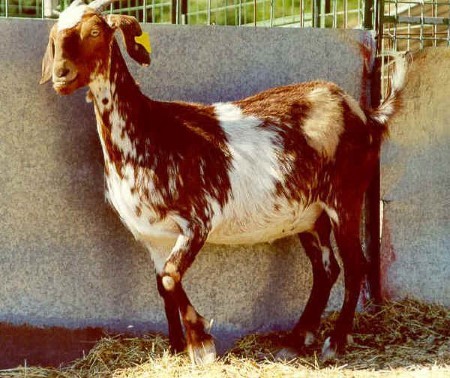
|
Pezzata Rossa Goats, likely related to Neapolitan Goats, are prominent dairy goats found across various provinces of Campania, Italy. Known for their dairy prowess, these goats boast a distinctive coat characterized by a red pied pattern with irregular edges. Some individuals may also feature a white face mask, adding to their unique appearance. Both males and females of this breed typically bear horns, contributing to their traditional aesthetic
...
|
|
 Philippine Philippine
|
|

|
In the Philippines, two varieties of goats are predominantly raised for meat production.
The first variety is characterized by coarse hair and typically comes in cream, tan, or light brown colors. These goats are usually polled, meaning they lack horns.
The second variety is distinguished by fine hair and possesses horns. They are commonly found in black or brown hues and may exhibit a white belt marking. It is believed that
...
|
|
 Poitou Poitou
|
|

|
Poitou goats, a scarce dairy breed originating from the picturesque landscapes of western France, represent a treasured gem in the world of goat husbandry. Renowned for their rarity, these goats boast distinctive characteristics that set them apart from their counterparts.
Typically found in a polled variety, Poitou goats sport luxurious long hair coats that exude elegance and grace. Their striking appearance is characterized by a capt
...
|
|
 Pomellata Pomellata
|
|
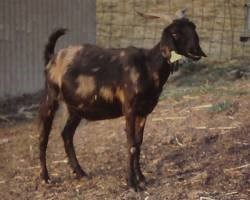
|
Pomellata Goats, originating from the Campania region of Italy, are a distinctive breed renowned for their unique morphological and economic characteristics. These goats are often raised near the ConSDABI (Consortium for Experimentation, Divulgation, and Application of Innovative Biotechniques) in Circello, Benevento, where they thrive in the local environment.
Morphologically, Pomellata Goats are characterized by their moderate weight
...
|
|
 Potenza Potenza
|
|
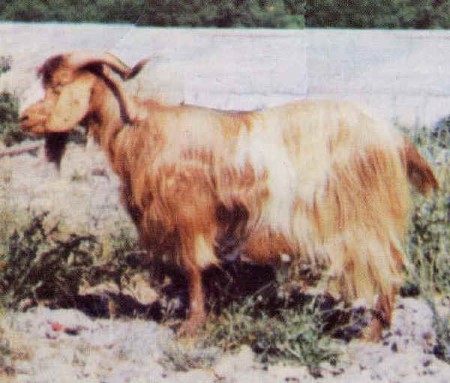
|
Potenza Goats, aptly named "Power Goats" after their origin in the Potenza Province of Italy, epitomize strength and resilience. Derived from a lineage of local breeds including Cilentana, Garganica, and possibly Girgentana Goats, they have adapted seamlessly to the rugged terrain and arid soils that characterize their native environment.
Cloaked in a spectrum of colors ranging from serene grey to deep black and earthy brown, Potenza G
...
|
|
 Pygmy Pygmy
|
|

|
Pygmy Goats were originally
called the Cameroon Dwarf Goat since they originated in the former French
Cameroon area. They are mostly found in West African countries. Similar forms
of Pygmy goats also are found across northern Africa, southern western African
countries, and in east Africa.
The Cameroon goats were
exported from Africa to zoos in Sweden and Germany where they were on display
as exotic animals. The first Pygmys proba
...
|
|
 Pygora Pygora
|
|

|
Pygora goats are a breed of
fiber goat that originated from crossing Pygmy Goats and Angora Goats.
The Pygora was a purposeful
cross, bred by Katharine Jorgensen of Oregon City, Oregon. In 1987, the Pygora
Breeders Association was formed in the United States, and has since then been
registering and promoting Pygoras. Today, the registered Pygora goat may not be
more than 75% AAGBA-registered Angora goat or 75% NPGA-registered Pyg
...
|
|
 Pyrenean Pyrenean
|
|

|
Pyrenean Goats, originating from the rugged landscapes of the Pyrenees in France and Spain, as well as the Cantabrian Mountains of Spain, are renowned for their dual-purpose nature, being bred for both milk and meat production. Their adaptation to the mountainous terrain of these regions has endowed them with unique characteristics ideal for their multifaceted role in agriculture.
Typically adorned in dark brown or black coats with a
...
|
|
 Qinshan Qinshan
|
|
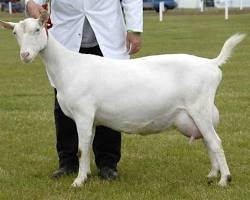
|
Qinshan Goats, native to the picturesque region of Jining in Shandon, China, are revered for their striking black coats that shimmer against the backdrop of their pastoral surroundings. Unlike many other goat breeds raised primarily for milk or meat, these goats are cherished for the luxurious quality of their pelts, which boast a deep ebony hue that captivates the eye.
Raised amidst the verdant landscapes and rolling hills of Jining,
...
|
|
 Red Boar Red Boar
|
|
|
Red Boar Goats, originating from the rich lands of South Africa, stand as a versatile breed valued for both their meat production and companionship as pets.
These goats, with their robust build and distinctive red-brown coats, exemplify the essence of meat production, providing succulent and flavorful meat to discerning consumers. Their meat conformation is highly regarded, reflecting their genetic heritage and the meticulous breeding
...
|
|
 Red Mediterranean Red Mediterranean
|
|

|
Red Mediterranean, or Rosa Mediterranea, Goats originally
came from central-eastern Mediterranean, particularly Syria. They have a
reddish-brown coat. They are mainly bred for milk for making cheese.
Rossa Mediterranea, or Derivata di Siria, Goats are from the Mediterranean
island of Sicily, in southern Italy. They were derived from Siria or Mambrina,
Goats. They are raised mainly in Sicily, but also in Basilicata and
...
|
|
 Repartida Repartida
|
|
|
Repartida Goats hail from the northeastern region of Brazil, meticulously crafted through selective breeding from the esteemed Chué goat lineage. Inheriting the robust meat-oriented traits of its progenitor, this breed embodies the epitome of functionality and purpose. Characterized by its distinctive coat pattern, the Repartida Goat boasts contrasting hues, with black forequarters seamlessly transitioning into brown or pale hindquarters, and vic
...
|
|
 Roccaverano Roccaverano
|
|
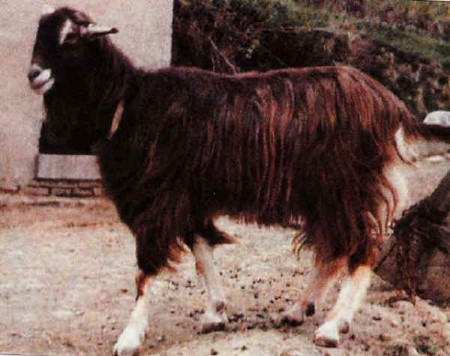
|
Roccaverano Goats, regarded as an indigenous breed of the Alta Langa Val Bormida region in Italy, proudly stand as the most prevalent goat breed in their ancestral homeland. Belonging to the esteemed Alpine group of Goats, they embody the rugged spirit of their mountainous terrain.
Draped in a luxurious long-haired coat that showcases a splendid array of colors, ranging from serene beige to bold black, pristine white, or earthy brown,
...
|
|
 Rocky Mountain Rocky Mountain
|
|

|
The Mountain Goat, known scientifically as Oreamnos americanus and colloquially as the Rocky Mountain Goat, is an emblem of North America's rugged wilderness, where it navigates the sub-alpine and alpine landscapes with remarkable agility and grace.
This majestic creature, native only to North America, epitomizes adaptability to its high-altitude habitat, where it roams the Rocky Mountains, Cascade Range, and other western mountain reg
...
|
|
 Rove Rove
|
|

|
Rove Goats were first
domesticated in Le Rove, France near Marseille. They were once considered
endangered, but as of 2003, there are more than 5000 registered Roves on French
farms. The goat was originally bred for meat, but because the current French
market for goat meat is poor, farmers have begun to use the Rove for dairying,
instead.
Rove Goats are primarily
characterized by its long twisted horns. They can reach nearly 4 ft
...
|
|
 Russian White Russian White
|
|

|
Russian White
Goats are, unsurprisingly, white goats from
Russia. They are dairy goats derived from the selective breeding ofSaanenand Toggenburg
goatsimported from Switzerland,
crossed with various native goat breeds of the former USSR.
Hairy goats,
of the Saanen and Toggenburg breeds, have been imported periodically from
Switzerland and other European countries; these breed undoubtedly contributed
much to the formation of vari
...
|
|
 Rustica di Calabria Rustica di Calabria
|
|
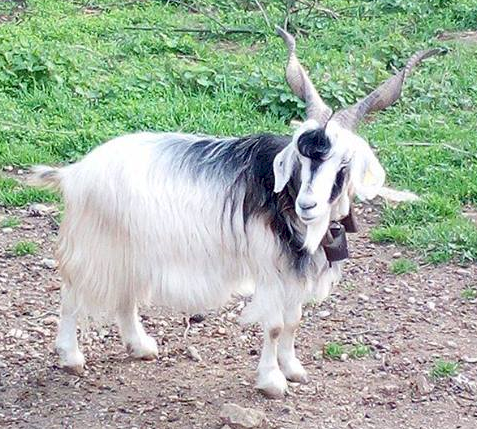
|
Rustica di Calabria Goats, an esteemed Italian breed, are nurtured in the picturesque province of Cosenza, nestled within the scenic landscapes of Calabria. Characterized by their diverse and heterogeneous features, these goats are believed to have inherited their distinctive traits through a blend of ancestry, possibly incorporating influences from Maltese and Garganica Goats.
Raised amidst the rugged terrain of the mountains, Rustica
...
|
|
 Saanen Saanen
|
|
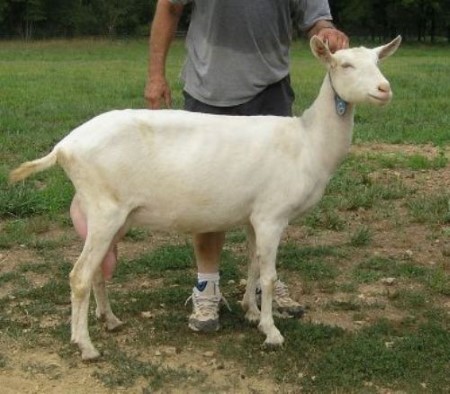
|
Saanen Goats
are dairy goats that originated in Switzerland, in the Saanen Valley. By the late 19th century they had
spread across Europe, and in the early 20th century were brought to the US. Now
they are among the most popular dairy goat breeds, due to their high
productivity and ease of management.
Saanen does
are heavy milk producers and usually yield 3-4 percent milk fat. They are medium to large in size (weighing
approxim
...
|
|
 Sable Saanen Sable Saanen
|
|

|
The Sable Saanen Goat, a recognized breed by the American Dairy Goat Association (ADGA), is primarily bred for milk production. It originated from Saanen goats brought to America by European settlers. In 2005, the Sable Saanen was officially acknowledged as a separate breed, distinct from its Saanen ancestors.
Before their recognition as a distinct breed, Sable Saanen goats were often culled due to their color variations, which result
...
|
|
 Sahelian Sahelian
|
|

|
Sahelian Goats are from West
Africa, especially in north and northwest Mali. They are used for the
production of meat, goatskin, and very rarely milk.
Sahelian Goats belong to the
Savanna group of goats with many types and subtypes raised in the Saharan and
sub-Saharan region.
They have a thin appearance,
narrow body, shallow chest, and sloping short croup. Both genders are horned,
most (70%) with wattles, pendent or
...
|
|
 Salerno Salerno
|
|
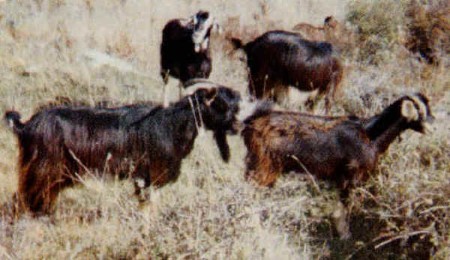
|
Hailing from the picturesque province of Salerno in Italy, Salerno goats stand as sturdy pillars of the region's pastoral heritage. Clad in coats of uni-colored black or brown, these goats epitomize simplicity and resilience in their appearance.
Despite their unassuming coloration, Salerno goats are valued for their impressive productivity, yielding an average of 250 kilograms per lactation. This respectable output underscores their si
...
|
|
 San Clemente Island San Clemente Island
|
|

|
San Clemente Island Goats are
derived from feral goats isolated on San Clemente Island, one of the Channel
Islands off the coast of California. They are thought to be descended from goats brought
to the island by Spanish missionaries and settlers; breeds such as the La
Blanca Celtiboras, the La Castellana Extremenas, and later the more common
dairy and meat goats of Spain, the Malaguenas and Murcianas.
The U.S. Navy became
responsib
...
|
|
 Sarda Sarda
|
|

|
Sarda Goats, native to the enchanting Mediterranean island of Sardinia, situated off the west coast of central Italy, epitomize resilience and adaptability in the rugged landscapes of their homeland. Thriving throughout the island, particularly in the provinces of Cagliari and Nuoro, these goats trace their lineage back to ancient times and bear the indelible imprint of Maltese influence.
Characterized by a medium build, elongated neck
...
|
|
 Savanna Savanna
|
|
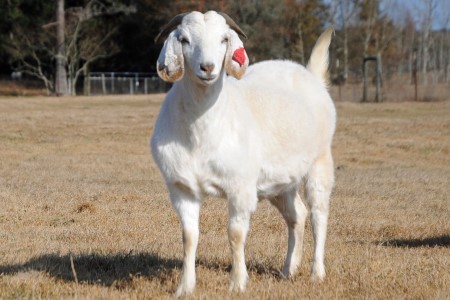
|
Savanna Goats are a high-quality white meat were developed
from native South African goats.
For years various south African farmers bred what was then
known as white Boer goats for a number of years in South Africa. One of the
advantages of these white goats was the fact that the white color is dominant
over most other colors. The other reason is that there is a big demand for
white goats for slaughter purposes for various reason
...
|
|
 Screziata Screziata
|
|
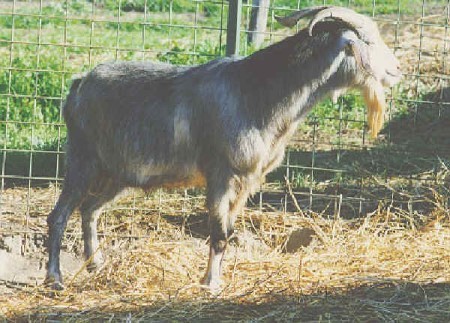
|
Originating from the picturesque landscapes of the Campania region in Italy, Screziata Goats stand as a testament to the region's rich agricultural heritage and natural diversity. With a history deeply rooted in the rural traditions of southern Italy, these goats have become emblematic of the region's pastoral landscapes and cultural identity.
Screziata Goats boast a distinctive appearance characterized by their unique coat coloration
...
|
|
 Selvatica di Galite Selvatica di Galite
|
|
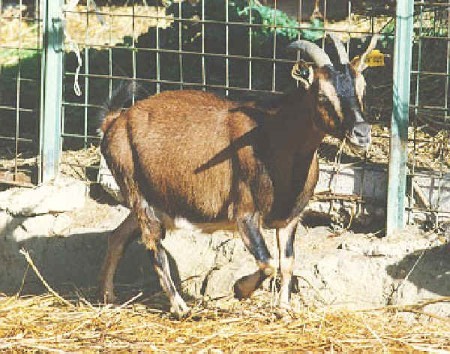
|
The remarkable Selvatica di Galite Goats, renowned for their rugged resilience and distinctive characteristics, find themselves thriving in the nurturing care of dedicated breeders near the ConSDABI (Consortium for Experimentation, Divulgation, and Application of Innovative Biotechniques) located in Circello, Benevento. Nestled amidst the picturesque landscapes of southern Italy, these exemplary goats epitomize the enduring spirit of traditional
...
|
|
 Selvatica di Joura Selvatica di Joura
|
|
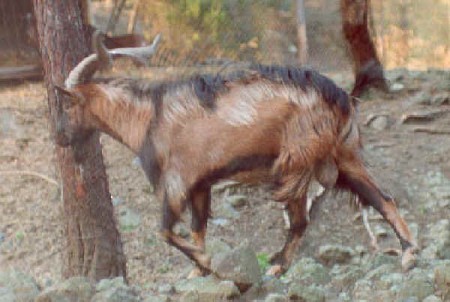
|
Selvatica di Joura Goats, distinguished specimens of their breed, thrive in the vicinity of the ConSDABI (Consortium for Experimentation, Divulgation, and Application of Innovative Biotechniques) located in Circello, Benevento. In this picturesque setting, nestled amidst the rolling hills and verdant landscapes, these goats are raised with meticulous care and attention to detail.
Under the stewardship of the ConSDABI, these exemplary g
...
|
|
 Selvatica di Samotracia Selvatica di Samotracia
|
|
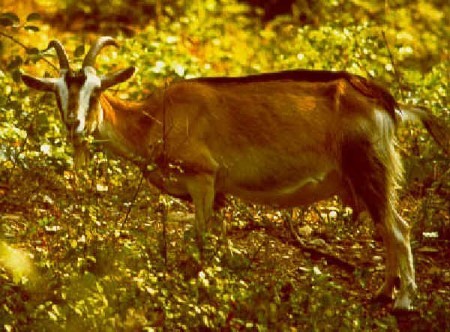
|
Near the esteemed Consortium for Experimentation, Divulgation, and Application of Innovative Biotechniques (ConSDABI) in Circello, Benevento, some exemplary specimens of Selvatica di Samotracia goats graze and thrive. These goats, with their ancestral ties and rustic charm, embody the essence of resilience and adaptation in their natural environment.
Residing in the lush landscapes surrounding Circello, Benevento, these goats carry for
...
|
|
 Sempione Sempione
|
|
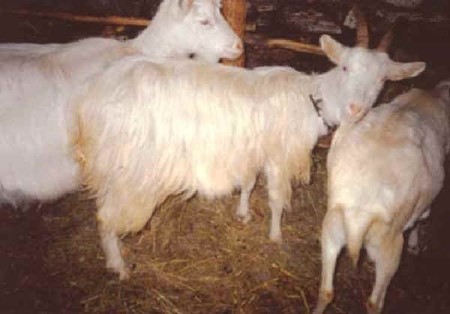
|
The Sempione goats, indigenous to the picturesque region of Alta Ossola in Italy, are a treasured but endangered breed facing the threat of extinction, with their population dwindling to fewer than 100 individuals. Revered for their resilience and adaptability to mountainous terrains, these goats have been an integral part of the local ecosystem for generations.
Adorned in a coat of pristine white, occasionally tinged with shades of br
...
|
|
 Somali Somali
|
|

|
Somali Goats, native to Somalia and northeastern Kenya, are primarily raised for meat production. These goats are characterized by their short ears and hair, which are typically white but may also feature spots or patches.
Both male and female Somali Goats possess horns, although females are often polled, meaning they naturally lack horns. Their adaptability to harsh environments is notable, as they are drought-tolerant and capable of
...
|
|
 Spanish Spanish
|
|

|
Spanish Goats, also called
brush goats or scrub goats, came originally from Spain via Mexico to the USA. They
are now a meat and brush-clearing type found widely in the United States. In
the Southeast and elsewhere, they are often referred to as "wood"
(Florida), "brush" or "briar" (North Carolina, South
Carolina), "hill" (Virginia), and "scrub" (midwest
Pennsylvania) goats. Until recently, these goats were kept mainly for clearing
brush a
...
|
|
 SRD (Sem Raça Definida) SRD (Sem Raça Definida)
|
|
|
SRD Goats, hailing from the northeastern reaches of Brazil, represent a robust and hardy meat breed known by the acronym SRD, which translates to "Sem Raça Definida" in Portuguese, meaning "without defined breed." This nomenclature underscores the rustic and unpretentious nature of these goats, who thrive in the rugged terrain and climatic conditions of the Brazilian hinterlands.
Bearing no specific breed designation, SRD Goats epitomi
...
|
|
 Stiefelgeiss Stiefelgeiss
|
|

|
Stiefelgeiss goats, a meat breed originating from the highlands of St. Gallen, Switzerland, currently have a population of less than one thousand.
Both male and female Stiefelgeiss goats are horned and exhibit a coat that ranges from a light greyish brown to a dark reddish color. While they are not excessively shaggy overall, they have distinctive long beard hairs, known as "Mänteli," that grow particularly long on their hind end. Thes
...
|
|
 Surati Surati
|
|
|
Surati goats, a beloved milk goat breed hailing from India, are recognized for their valuable contributions to dairy farming. With their medium size and distinctive white coats, Surati goats are easily identifiable in their native regions. Their ears, of moderate size, complement their overall appearance, while both females and males possess small horns, adding to their unique characteristics.
These goats are cherished for their abilit
...
|
|
 Swedish Landrace Swedish Landrace
|
|

|
Swedish Landrace goats, native to the northern regions of Sweden, are renowned for their exceptional milk production, which plays a pivotal role in the cheese-making industry. These goats are carefully bred and raised for their high-quality milk, which serves as a primary ingredient in the production of various types of cheese. With their robust constitution and adaptability to the Scandinavian climate, Swedish Landrace goats are valued for their
...
|
|
 Tauernsheck Tauernsheck
|
|

|
Now, let me spin you a tale about them Tauernsheck goats, hailing from the misty mountains of Austria, where the air is crisp and the valleys echo with the songs of old. These here goats ain't your run-of-the-mill kind, oh no. They're a rare breed, as elusive as the morning mist and as precious as a hidden gem.
You see, these Tauernsheck goats, they ain't just any goats – they're the guardians of the ancient art of milk production. Bor
...
|
|
 Tennessee Fainting Tennessee Fainting
|
|
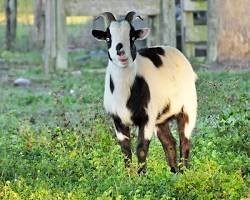
|
Tennessee Fainting Goats are also known as Myotonic, Tennessee
Meat, Texas Wooden Leg, Stiff, Nervous, and Scare goats.
The breed's history can be traced
back to the 1880s. An itinerant farm laborer named John Tinsley came to central
Tennessee, reputedly from Nova Scotia. Tinsley had with him four unusual, stiff
goats. Goats of this type gradually became known across the region. They were
less apt to climb fences and escape from
...
|
|
 Teramo Teramo
|
|
|
Hailing from the picturesque hills of the Teramo province in Italy, Teramo dairy goats embody the rustic charm and pastoral heritage of their native region. These goats, renowned for their dairy prowess, grace the verdant landscapes with their presence, contributing to the rich agricultural tapestry of the Teramo hills.
Adorned in a coat predominantly grey, reminiscent of the mist-kissed hills they call home, Teramo goats exhibit a spe
...
|
|
 Thuringian Thuringian
|
|

|
Thuringian Goats, a dairy breed native to the verdant landscapes of Thuringia in eastern Germany, trace their lineage back to a blend of Toggenburg, Harzerziege, Rhönziege, and Thüringer Landziege goats crafted with care around the year 1885. Over time, Swiss Toggenburg, Harzerziege, and Rhönziege bloodlines were introduced in the early 1900s, with Swiss Toggenburg making a return in 1988 to further refine the breed.
Adorned in a rich
...
|
|
 Toggenburg Toggenburg
|
|

|
Toggenburg Goats are a
Swiss dairy goat from Toggenburg Valley of Switzerland. They are considered to be
the oldest known dairy goat breed. They are medium size, sturdy, vigorous, and
alert in appearance.
Toggenburg goat hair is
short or medium in length, soft, fine, and lying flat. Its color is solid
varying from light fawn to dark chocolate with no preference for any shade. They
are also found with white ears with dark sp
...
|
|
 Uzbek Uzbek
|
|

|
Uzbek Goats
are from Uzbekistan and are used for the
production of mohair. They were developed by the
mating of predominantly white first and second generation crossbred females
with purebred white Angora males resulted in the appearance of 1-2% of black
kids.
After 4-5 years, there were
already several hundred black wool goats; they were gathered into one herd and
females were mated only to black males. Such mating produced in
...
|
|
 Valais Blackneck Valais Blackneck
|
|

|
Valais Blackneck Goats, a versatile breed renowned for their dual-purpose capabilities, are primarily found in Switzerland, Italy, Austria, and Germany. Their striking appearance is characterized by a distinctive color pattern, with black extending from the nose to behind the shoulder, while the rest of their body, from there to the tail, is adorned in white.
These goats are bred for both meat and dairy production, making them highly v
...
|
|
 Valdostana Valdostana
|
|
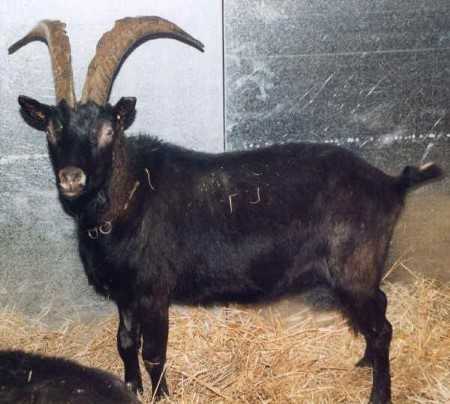
|
In the rolling hills of the Italian countryside, where the whispers of the wind dance through the valleys, there exists a breed of goats unlike any other. Valdostana goats, reminiscent of their Alpine counterparts, possess a charm uniquely their own. Their stature, though reminiscent of the Alpine breed, carries a distinctiveness - a square-built shape that sets them apart in the lush landscapes they call home.
But it is not merely the
...
|
|
 Valle dei Mocheni Valle dei Mocheni
|
|
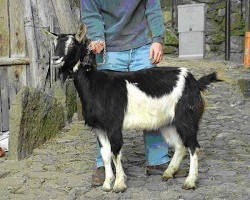
|
Surati goats, a beloved milk goat breed hailing from India, are recognized for their valuable contributions to dairy farming. With their medium size and distinctive white coats, Surati goats are easily identifiable in their native regions. Their ears, of moderate size, complement their overall appearance, while both females and males possess small horns, adding to their unique characteristics.
These goats are cherished for their ability to pro
...
|
|
 Valle del Chiese Valle del Chiese
|
|
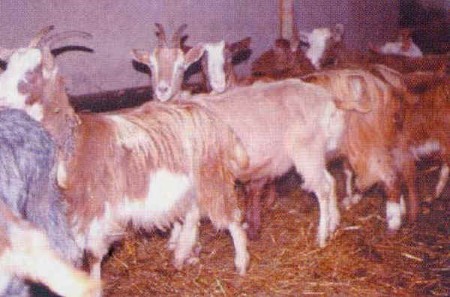
|
Valle del Chiese Goats, hailing from the breathtaking Chiese Valley in Italy, are not only a symbol of the region's rugged beauty but also an integral part of its agricultural heritage. Bred for their adaptability to the challenging mountainous terrain and diverse climatic conditions of the valley, these goats excel in both meat and milk production.
Raised amidst the stunning natural landscapes of the Chiese Valley, Valle del Chiese Go
...
|
|
 Valle di Fiemme Valle di Fiemme
|
|
|
Valle di Fiemme Goats hail from the picturesque Fiemme Valley in Italy, a region renowned for its stunning natural landscapes and rich agricultural heritage. Nestled within the heart of the Italian Alps, this valley provides an idyllic environment for the development of these goats.
These goats are celebrated for their unique characteristics and contributions to the local farming traditions. Known for their medium to large size, Valle
...
|
|
 Vallesana Vallesana
|
|
|
Vallesana Goats, also known by various names such as Col Noir de Valais, Valaisan a col noir, Walliser Schwarzhals, Schwarzweisse Walliser Sattelziege, Vallesana del collo nero, Vallese, Chevre des Glaciers, and Valais Blackthroat, are an Italian breed primarily found in the border region between South Novarese (Piedmont) and the Swiss canton of Valais.
These goats thrive in the mountainous terrain of the province of Verbania and Verce
...
|
|
 Valtellina Valtellina
|
|
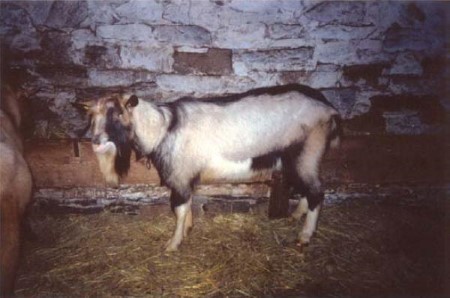
|
.In the picturesque valleys of Valtellina, Valmalenco, and Valchiavenna, Italy, roams a breed of goats as majestic as the rugged landscape they call home - the Pedula della Valtellina. These medium-large creatures, reminiscent of their Alpine counterparts, grace the fertile pastures with their gentle presence and sturdy demeanor.
Admired for their dairy prowess and docile disposition, the Pedula della Valtellina embodies the essence of
...
|
|
 Verata Verata
|
|

|
Verata Goats are a medium-small
meat and dairy breed found in Vera, Caceres, Spain. They have twisted horns and
they are chestnut, black, or grey colored. They are very hard and fairly easy
to handle and they can adapt easily to different management systems.
Verata Goats are best adapted
to mountain pastures because they have strong, long legs, and they can also
survive on poor and scarce feed.
They are valued for the
...
|
|
 Waipu Waipu
|
|
|
At Waipu, the northern part of
the North Island, New Zealand, there is a small flock of feral goats, probably
the remnants of Angoras farmed in the area since the late nineteenth century.
It is believed that there are now very few left in the bush area to which they
were originally confined, the main population currently being held by a member
of the Rare Breeds Conservation Society.
These may be all the Waipu
goats now remaining
...
|
|
 West African Dwarf West African Dwarf
|
|

|
In the sultry embrace of coastal West and Central Africa, amidst the lush tapestry of verdant landscapes, roams the noble West African Dwarf Goat. A creature of humble origins yet endowed with a lineage of remarkable significance, it stands as the progenitor of esteemed breeds that have traversed oceans and continents, leaving an indelible mark on distant lands.
From its ancestral domain, this diminutive yet robust goat has woven the t
...
|
|
 White Shorthaired White Shorthaired
|
|

|
White Shorthaired goats are dairy
goats from the Czech Republic. They are the result of selective breeding of
native Czech landrace goats crossed with Swiss Saanen goats in the early 1900s.
they were recognized as a breed in 1954-55 and is now found throughout the
Czech Republic.
White Shorthaired goats are similar
to the Saanen in appearance; they are white and shorthaired. Some strains
maintain the characteristic Saanen's black
...
|
|
 Xinjiang Xinjiang
|
|

|
Xinjiang goats, native to the mountainous region of Xinjiang in China, are prized for their multifaceted utility in milk, cashmere, and meat production. With their presence in the rugged terrain of Xinjiang, these goats have adapted to thrive in challenging environments.
Bred for their versatility, Xinjiang goats are valued for their ability to produce high-quality milk, coveted cashmere fiber, and flavorful meat. Their coats come in v
...
|
|
 Xuhai Xuhai
|
|
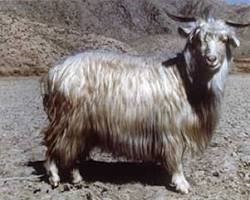
|
Xuhai goats, a specific variety of Huanghuai Goat native to the Jiangsu province of China, are meticulously bred for their exceptional qualities in meat production. These goats are a prized asset in the agricultural landscape of Jiangsu, renowned for their robust build and superior meat yield.
Characterized by their sturdy physique and efficient meat conformation, Xuhai goats are bred with a primary focus on maximizing meat production.
...
|
|
 Yemen Mountain Yemen Mountain
|
|
|
Yemen Mountain goats are characterized by their long, flowing hair and are typically found in the mountainous regions of northern Yemen. These goats often exhibit a striking black coloration, blending seamlessly with the rugged terrain of their natural habitat. With their resilient nature and adaptation to mountainous environments, Yemen Mountain goats play a vital role in the local ecosystem and are valued for their hardiness and unique appearan
...
|
|
 Zalawadi Zalawadi
|
|

|
Zalawadi goats, native to the Surendranagar and Rajkot regions of Gujarat, India, are prized for their versatility and multi-purpose utility in local agriculture. Belonging to the Gujarati type, these goats are highly valued for their contributions to milk, meat, and fiber production, making them indispensable assets for farmers in the region.
One of the distinguishing features of Zalawadi goats is their erect corkscrew-shaped horns, w
...
|
|
 Zhiwulin Black Zhiwulin Black
|
|

|
Now, let me paint you a picture of them Zhiwulin Black Goats, roamers of the rugged northern Shaanxi region in China. Picture this: rolling hills, a crisp breeze cutting through the air, and these goats, black as the night sky, grazing freely amidst the wild.
These ain't your ordinary goats, no sir. These Zhiwulin Black Goats are prized for their dual-purpose prowess – cashmere and meat, a combination as rare and valuable as a hidden t
...
|
|
 Zhongwei Zhongwei
|
|

|
Zhongwei goats are only from the arid desert steppes of the
Ningxia Hui Autonomous Region and Gansu Province of China. They are bred
primarily for the production of kid pelts, and secondarily for cashmere fiber.
They live chiefly, if not solely, on salty or sandy plants
or shrubs.
Both genders are horned with the male's horns stretching
upward and twisted. The males average 39 kg (85 pounds) and females 24.5 kg (55
pou
...
|
![]()
© 2007 - 2025 Copyright Global Grange inc. All Rights Reserved.
|
